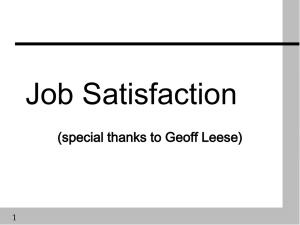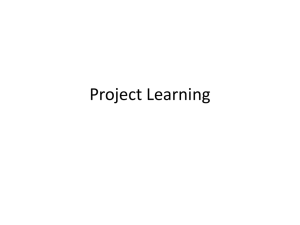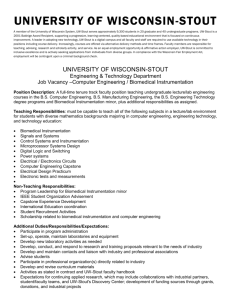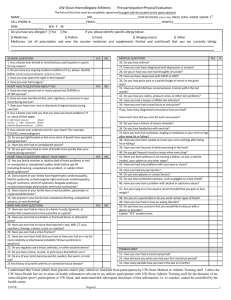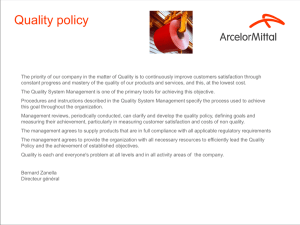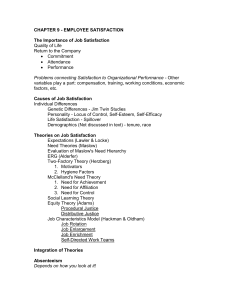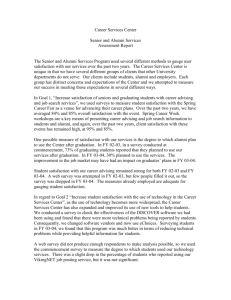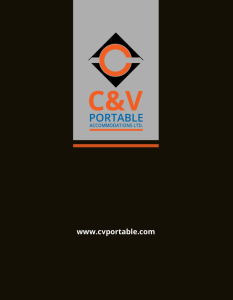A Study of Student Satisfaction ofUW
advertisement
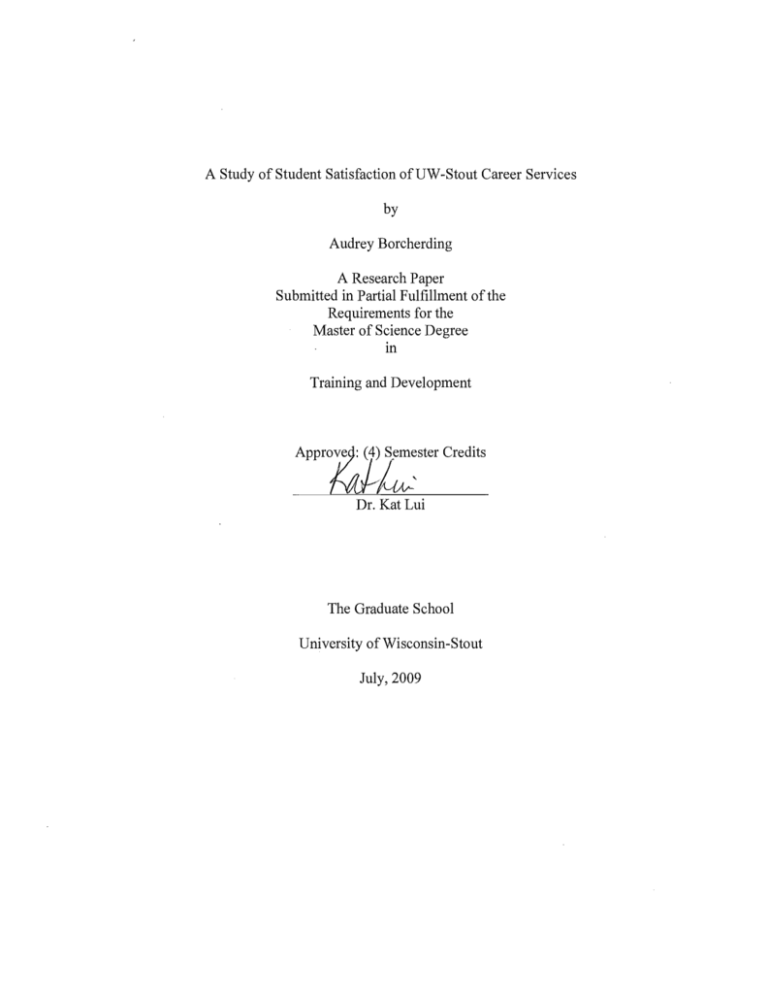
A Study of Student Satisfaction ofUW-Stout Career Services by Audrey Borcherding A Research Paper Submitted in Partial Fulfillment of the Requirements for the Master of Science Degree In Training and Development : (4) S.emester Credits iVv-' Dr. Kat Lui The Graduate School University of Wisconsin-Stout July, 2009 ii The Graduate School University of Wisconsin-Stout Menomonie, WI Author: Borcherding, Audrey R. Title: A Study of Student Satisfaction of UW-Stout Career Services. Graduate Degree/ Major: M.S. in Training and Development Research Adviser: Kat Lui, Ph.D. Monthrfear: July, 2009 Number of Pages: 35 Style Manual Used: American Psychological Association, 5th edition ABSTRACT This study was utilized to determine the student satisfaction levels of services at the UW-Stout Career Services Office. The questions in this study sought to discover how satisfied UW-Stout students are with their experiences at Career Services as well as how prepared they feel for the workforce due to Career Services. A 12 question student satisfaction survey was administered to 1,511 UW-Stout senior students. The survey presented demographic data as well as four major themes to be researched further: a majority of students did not use Career Services, the website technology needs improvement, design, psychology, education, and family studies students feel underserved, and there needs to be more variety of employers at the Career Fair. These four conclusions are a starting point for further research and improvement opportunities within Career Services at UW-Stout. iii The Graduate School University of Wisconsin Stout Menomonie, WI Acknowledgments My journey through the Masters in Training and Development program has been amazing, challenging, and fulfilling. I want to thank Dr. Kat Lui for her support and leadership through the ups and downs of this project. I could not have done this without her friendship and direction. I also want to thank my husband for his understanding and support through this process. I cannot put into words the sense of accomplishment and satisfaction this experience has brought me. I would do it all again any day! iv TABLE OF CONTENTS ................................................................................................................................ Page ABSTRACT ................................................................................................................ ii List of Tables ......................................'......................... """."""""."".""."""."."".". vi " · 0 fF'Igures ........................................................................................................... Vll L1st Chapter I: Introduction ............................................................................................... 1 Statement of the Problem ........................................................................................... 2 Purpose of the Study .......................................................... ~ ....................................... 2 Assumptions of the Study ........................................................................................... 3 Methodology .............................................................................................................. 3 Chapter II: Literature Review ..................................................................................... 4 Chapter III: Methodology .............................. ""'''''''''' ............................................. 11 Subject Selection and Description .......................................................................... 11 Instrumentation ....................................................................................................... 11 Data Collection Procedures ................................................................................... 12 Data Analysis .......................................................................................................... 12 Limitations .............................................................................................................. 12 Summary ................................................................................................................. 12 Chapter IV: Results ................................................................................................... 13 Item Analysis ................................................................. ~ ......................................... 13 Chapter V: Discussion.............................................................................................. 19 Limitations .............................................................................................................. 19 Conclusions ............................................................................................................. 19 v Recommendations ................................................................................................... 25 References ................................................................................................................. 26 Appendix A: Spring '09 UW-Stout Career Services Student Survey ...................... 28 vi List of Tables Table 1: Online Employment Search Tools ...................................................... 5 Table 2: Please rate the services you used at Career Services ............................... 13 Table 3: Rate the following resources you have used in the Stout CareerLink ........... 14 Table 4: How did you hear about the events offered by Career Services? ................ 14 Table 5: How important is it to you to receive assistance with the following job search tasks? ............................................................................................. 15 Table 6: To what extent do you agree or disagree with the following statements? ........ .l5 Table 7: What is your major/program? ............................................................................ 17 Table 8: Whatis your gender? ........................................................................................... 18 Table 9: What is your U. S. citizenship/residency status? ................................................. 18 Table 10: What is your race/ethnicity? .............................................................................. 18 Table 11: Top three suggested marketing practices ............................................. 20 Table 12: Marketing practices that reached students initially ................................. 21 Chapter I: Introduction For career services, the period since the 1980s has been filled with change and innovation. Trends such as workplace restructuring, advancing technology, the global economy, and increased education in the workforce have piqued student interest in career decision making and employment skills. Career Services have responded with expanded programs including experiential education, career planning, technology-based applications, employment and continuing education services, and service learning (Ratcliffe, 2008). In recent years there has been a significant increase in the recognition of the importance of assessment in career services, and the significance is expected to grow in emphasis (Schuh and Up craft, 2001, Shea and Wesley, 2006). A survey conducted by the NACE Future Directions Task Force indicated that the most important future issue (4.6 on a 5 point scale) includes "Measuring the results of your office's programs and services," (Shea and Wesley, 2006). Many Career Services professionals are unfamiliar with conducting meaningful assessment, because it has not been a critical issue in the past. The student base served by the University of Wisconsin-Stout Career Services department includes traditional, international, and graduate students from all of the majors. This diversity of clients requires flexibility and innovation in services, in addition to a continuing assessment of their satisfaction and success. If effectively used, assessment can provide insight into how Career Services can better serve the student population. Assessment provides hard data that allows a department to set clear and measurable goals (Schuh and Upcraft, 2001, Shea and Wesley, 2006). The UW-Stout Career Services department has not utilized assessment in regard to student satisfaction. Like many other Career Services offices, they are feeling the increasing 2 pressure of doing assessment to prove the value of their programs and services (Schuh and Up craft, 2001, Keeling, Wall, Underhile, and Dungy, 2008). When determining their mission and goals for 2009; the UW-Stout Career Services office established a goal to "demonstrate effective communication and provide the highest level of customer service," (Career Services, UW-Stout, 2008). The office is particularly interested in the student perspective of their services, and they plan to begin measuring customer service success through this assessment of student satisfaction. This rest of this chapter will further outline the problem, signifincance, and purpose of the study. Statement of the Problem The UW-Stout Career Services department needs to assess the satisfaction levels of their student clients. This has not been done in the past and the new goals set by the department require the assessment of student satisfaction in order to determine how to improve services and offer the highest level of customer service. Purpose of the Study This study seeks to develop and administer an assessment survey to determine senior students' satisfaction in regard to Career Services programs at the University of WisconsinStout. The goal of the assessment is to determine the changes and innovations necessary to improve Career Services and students' perceived levels of preparedness for their work lives. The survey tool and results will be used as a starting point for continual Career Services assessment, with the goal of fully understanding the student perspective. 3 Assumptions of the Study There are two primary assumptions to the study. The first is the assumption that students will respond to the survey, additionally, that they will respond in an honest manner. A second assumption is that the Career Services department will utilize the study results to further the research on student satisfaction to determine necessary changes in the department. Limitations of the Study , The limitations of the study include the sample population and the survey response rate. The scope of this project will include the 90-credit and higher senior class at UW-Stout. This population may be difficult to receive feedback from, considering the numerous obligations they have during their senior year. The survey will be administered in early April to maximize the chance of a significant return rate. This time falls just after the spring break and well before final exam week. An additional limitation is the fact that not all UW-Stout students were surveyed. For the purpose of this study, the senior student population was a manageable start to the assessment process. However, by not including the entire student body, the data may not offer a complete representation of all student satisfaction levels. Methodology The study will utilize an online survey tool with anonymous response, to preserve the anonymity of participants. 4 Chapter II: Literature Review This chapter will cover the factors leading to the need for assessment. These factors include the evolving technology and workforce, increased pressures on higher education departments and the need to understand the student perspective. Trends such as workplace restructuring, advancing technology, the global economy, and increased education in the workforce have piqued student interest in career decision making and employment skills (Ratcliffe, 2008). This increased interest in combination with an evolving workforce, and developing pressures for accountability in student services has made assessment a necessity. Student satisfaction and perceived preparedness are two essential questions Career Services are being pressured to ask. Changing Technology In Career Searches Changing technologies have prompted changes in counseling students in Career Services. Career Services at the University of North Carolina at Chapel Hill surveyed employers to test Career Services' and students' assumptions about job search practices (Gist and Harris, 2007). As the survey was discussed by the Career Services counselors; it become clear that there was a generation gap within the staff. One question that caused discussion was in regard to students listing basic computer skills, such as Word on their resumes. Current students would no more include basic knowledge of Word than they would list their ability to use a television remote (Gist and Harris, 2007). The results of the survey underscore the fact that as the world of work and technology is changing, career offices need to ensure that the information and advice provided to students reflect those changes (Gist and Harris, 2007). Technology is a developing factor that cannot be ignored by Career Services. The development of social networking sites has changed the face of job-searching and networking for 5 generations to come. Career Services and employers alike are feeling behind the times when it comes to the use of online technologies by students (Shea and Wesley, 2006). It is especially important for Career Services staff to understand social networking as employers are increasingly utilizing these sites to screen candidates. A study by executive search firm ExecuNet found that 77% of recruiters search for candidates on the Web to screen applicants; 35% of these same recruiters say they have eliminated a candidate based on the information they uncovered (Lorenz, 2007). The following table lists examples of new career search technologies being used. Table 1 Online Employment Search Technologies Tool Career Tech Portfolios InterviewStream Social networking sites (Facebook and LinkedIn) CareerLink databases Description Online program providing planning, reflection, skill and portfolio development. Conduct interviews via web cam, for practice or actual interviews Worldwide social and professional networking sites Employment databases offering students the opportunity to search for positions worldwide It is also important for Career Services to develop programming to help students safely optimize internet tools in their job search and networking practices (Lorenz, 2007, Shea and Wesley, 2006). Career Services can also utilize the internet tools to better reach the student population with their marketing efforts. The traditional ways of marketing services to students are being pushed aside by social networking, texting, and instant messages. Technology updates have also pushed Career Services departments to change their traditional career preparation strategies. In response to advancing technology, Career Services 6 have implemented web-based career development tools. Georgia Tech offers a "CareerTech Portfolio" option to its students. The online program prepares students for the future through planning, reflection, skill development, and portfolio development (Georgia Tech Institute of Technology, 2006). The institute also offers virtual career fairs to students, allowing them to be present from any location. Massive job and internship/co-op networks are also becoming the norm in Career Services, connecting students worldwide to job and co-op opportunities. Interviewing skills are also being developed through technology. The Rochester Institute of Technology is one among many who offers "InterviewStream". The program allows students to conduct an interview via web cam. This tool provides feedback and tips of non-verbal behavior and communication missteps, and is helpful for objective program coordinator assessment (Rochester Institute of Technology, 2008). Changing Worliforce Requirements Beyond the basics of job search techniques is the ever-changing workforce and workplace structure. As new generations enter the workforce, different values and work ethics are being revealed (Franer and Brown, 2006). Ideas of long-term commitment, work hours, and loyalty are changing with the new generations. Increasingly employers state that their current group of novice employees appears unable to delay employment gratification and think long term (Farner and Brown, 2006). According to Levine (2005), "we are witnessing a pandemic of what I call, 'worklife unreadiness' ." Current members of the workforce assume that new generations will bring the same desires, expectations, and values as theirs; however this is not happening (Marston, 2005). Career Services departments must be aware of these differences to better prepare students for 7 entering the workforce and understanding what may be expected of them. The first step in preparing students is to understand their perspectives on career development. Awareness ofStudent Perspectives Career counselors must also be closely involved with developing students' career selfefficacy. Not only is it important to understand student satisfaction ratings, but to understand their levels of perceived preparedness. Self-efficacy beliefs are predictive of career entry behavior (Niles, Erford, Hunt and Watts, 1997). By examining the relationships between decision-making and career self-efficacy, practitioners can use the information to construct program interventions to enhance students' career development (Niles et.al., 1997). Niles et.al., (1997) conducted a study to determine the relationship between career selfefficacy, career development, and decision making styles. They used the Career Decision Making Self-Efficacy Scale to measure career self-efficacy. The scale uses 50-items to measure self-efficacy expectations relative to career decision making tasks which include self appraisal, gathering information, selecting goals, making future plans, and problem solving (Niles et.al., 1997). They also utilized the Decision-Making Inventory tool to measure decision making styles. The DMI uses 12 items to assess spontaneous versus systematic and internal versus external decision-making styles (Johnson, 1978). Career development was measured using the Survey of Career Development (Rayman & Super, 1978). The survey measures values, interests and abilities, decision making statements, occupation statements, and career planning statements. The study found that students who utilize systematic-internal decision making tend to be less advanced in their career development and less confident in completing career development tasks than those using a systematic-external style. Students with the highest career-decision making and self-efficacy and the lowest career indecision were those practicing systematic- 8 external decision making with clarified values and acquired occupational information (Niles, et.al., 1997). These students displayed abilities to perform career research more independently than others. The study results point to the need for career services to be sensitive to students' preferences for gathering and analyzing career data. In addition, the results indicate the type of career assistance different groups of students may benefit from. Students not practicing systematic-external decision making should be counseled in a manner sensitive to their limitations and effective in developing their decision making skills. The study highlights the need for more than a generic approach to Career Services. Student satisfaction combined with self-efficacy data can offer Career Services a more complete picture of the effectiveness of the programs being offered. Pressure on Student Services Conducting assessment proj ects is essential to continued improvement in student services departments, specifically Career Services. According to Schuh (2009) Stakeholders for these entities are demanding demonstrations of accountability and organizational effectiveness. Funding is becoming increasingly tied to a programs ability to prove their effectiveness in making a difference in higher education (Schuh, 2009). Assessment in higher education primarily responds to two factors: internal commitments and external demands for accountability (Keeling, Wall, Underhile, & Dungy, 2008). Internal commitments include effectiveness of programs, satisfaction of clients, and fulfillment of department goals. External demands consist of pressures from executive boards, community members, government, and other taxpaying entities for higher education departments to have accountability for the dollars they are spending. In order to meet these accountability 9 expectations and implement improvement processes, Career Services staff must develop and assess definitive program and student outcomes (Ratcliffe, 2008). Assessment in Career Services can be viewed as a listening post to help staff document their work and meet accountability and improvement requirements (Ratcliffe, 2008). Operational effectiveness views the following when determining success: • Utilization of services • Quality of services • Satisfaction of stakeholders • Efficiency of programs Assessment results can be used in program evaluation, strategic planning, process improvement, and to increase student satisfaction (Ratcliffe, 2008). "Student satisfaction with services and programs is the key to quality improvement. Nowhere is this more true than in a customer-focused enterprise such as Career Services (Schuh and Upcraft, 2001, p.2)." There is increased importance in providing good services to students, much like you would expect in any consumer goods or service industry. Higher education institutions have continued their interest in assessing student satisfaction. This persistence is consistent with the relationship contemporary students want with their university or college (Schuch & Upcraft, 2001). "The business of assessment, then, is the business of the university itself. The institution has the responsibility to share its story with the public, which contributes so strongly to its financial viability through tax support, charitable contributions, and student tuition (Keeling et. aI.,2008)." 10 In conclusion, the factors affecting Career Services consist of workplace restructuring, technology advancements, increased pressure for assessment in higher education, understanding student perspectives, and student satisfaction. The information contained in this chapter offers a glimpse into why it is a necessity to assess Career Services at UW-Stout. The following chapter explains the methodology used to capture student perspectives on the effectiveness and importance of the services offered at UW-Stout Career Services. 11 Chapter III: Methodology This chapter includes the research methods and procedures used in this study. The stages are as follows: sample selection, survey instrument and pilot test, data collection methods, data analysis methods and the limitations. The research utilized an online survey tool to collect data on student satisfaction in regards to their experiences with UW-Stout Career Services. The data was used by the Career Services Director in strategic planning and process improvement projects. The method used by the researcher was guided by literature review, best practices, the Director of Career Services, and the research advisor. Subject Selection and Description The researcher used the senior student population, those with 90+ credits, at UW-Stout for the collection of student satisfaction data. There were a total of 1,511 UW -Stout students in the population, all of which were seniors preparing to graduate and enter the workforce. The survey tool was developed in cooperation with the interim director of Career Services at UWStout. The survey was pilot tested on a sample of senior UW-Stout students as well as the UWStout Career Services counseling staff. Instrumentation The survey tool was created based on literature review, career services input, and best practices guidelines. To meet the objectives of the study, the survey was administered to all UWStout senior students with 90 or more credits. The survey included questions regarding student satisfaction and perceived preparedness for the workforce, perceived importance of services, marketing outreach preferences, and basic demographics. The perceived importance questions were posed to determine how important the student felt the services were. The perceived preparedness questions were used to determine how prepared for the workforce the student felt, 12 as a result of using Career Services at UW -Stout. The survey tool was used to collect student satisfaction data that was implemented by the Director of Career Services in strategic planning, and process improvement programs. The data was also used to develop additional studies to gain more specific insight on each service offering. Data Collection Procedures A 12 question survey (Appendix A) was administered to the senior student population in April 2009. Surveys were administered via email, with an informed-consent statement and researcher contact information written on the introduction page of the survey tool. Each survey recipient had the opportunity to complete the survey one time. Each survey question offered the user the option to choose a "no comment or did not use" answer. The survey was sent three times over the course of three weeks, with the intent of increasing response rate. Data Analysis The researcher analyzed the data by determining what the major recurring themes were for each qualitative question. Quantitative questions were reported in table format with response percentages displayed for each question and sub-question. The analysis sought to determine areas of concern and needed improvement. It was also used to do comparative analysis between service areas and majors, to determine if specific areas or groups were being underserved. Limitations The project included the 90-credit and higher senior class. This population may be difficult to receive feedback from, due to the numerous obligations they have during their senior year. Another limitation is that not all UW-Stout students were surveyed. By not including the entire student body, the data may not offer a complete representation of all student satisfaction levels. 13 Chapter IV: Results In recent years there has been a significant increase in the recognition of the importance of assessment in Career Services, and the significance is expected to grow in emphasis (Schuh and Upcraft, 2001, NACE Journal, December 2006). The Career Services Department at UWStout has not conducted a student satisfaction survey in the past. The purpose of this study was to determine the senior students' satisfaction in regard to Career Services programs at the University of Wisconsin-Stout. The goal of the assessment was to determine the changes and innovations necessary to improve Career Services and students' perceived levels of preparedness for their work lives. The following chapter reports the results of the 12 question survey administered to 1,511 senior students with a total of 260 respondents or 17% response rate. Results have been reported by text and tables in regard to each individual question. Item Analysis Table 2 Please rate the services you used at Career Services. Excellent Good Fair Poor Did not use Scheduled appointment with Career Services Counselor. Classroom Presentation 23% (61) 28% (72) 5% (12) 1% (2) 43% (113) Response Total 260 18% (48) 41%(107) 7% (18) 2% (4) 32% (83) 260 Cooperative education program (please rate only if you have completed your co-op) Email Communication Resume andlor cover letter critique Workshops 22% (58) 23% (59) 4%(11) 3% (7) 48% (125) 260 28% (73) 20% (52) 38% (98) 33% (87) 7% (19) 5% (14) 2% (6) 3% (7) 25% (64) 38% (100) 260 260 18% (47) 28% (74) 5% (12) 2% (5) 47% (122) 260 Career Services web pages 24% (62) 36% (94) 18% (48) 6% (15) 16% (41) 260 Career Conference 30% (79) 31% (81) 11% (28) 7% (17) 21 % (55) 260 Peer mentor assistance 10% (27) 18% (47) 6% (16) 4% (10) 62% (160) 260 Service 14 The primary response to all categories in question one was "did not use." The noticeable theme in the data was that the majority of the senior students who responded had not utilized the Career Services listed. Table 3 Rate the following resources you have used in the Stout CareerLink. Resource Excellent Good Fair Poor Did not use Response Total Employers List 18% (45) 40% (101) 10% (26) 5% (12) 28% (70) 254 Job Vacancy List 17% (44) 33% (85) 15% (38) 8% (21) 26% (66) 254 On-campus Interview 16% (41) 29% (74) 10% (25) 5% (l3) 40% (101) 254 Career Events 15% (37) 36% (92) 10% (26) 4% (11) 35% (88) 254 EmployOn 14% (36) 20% (52) 8% (20) 2% (6) 55% (140) 254 ReferenceUSA 11% (27) 20% (51) 7% (18) 2% (5) 60% (153) 254 InterviewStream 7% (17) 16% (40) 5% (13) 2% (5) 70% (179) 254 Going Global 6% (14) 15% (37) 4% (11) 2% (5) 74% (187) 254 Job Search Videos 7% (19) 15% (38) 8% (21) 2% (6) 67% (167) 254 Mentor Search 4% (11) l3% (34) 6% (15) 4% (9) 73% (185) 254 Similarly to the results of question 1, the majority of students responded "did not use" to the resources listed in question 2. Table 4 How did you hear about the events offered by Career Services? Method Poster Faculty/Staff Other Students Email In-class presentation Website Walk-in Stoutonia Facebook Other Response Total Response Rate 51 142 80 167 77 101 25 12 20% 56% 31% 66% 30% 40% 10% 5% 4% 4% 11 9 15 The top three methods by which students heard about Career Service events were email, faculty/staff, and the website. These results were consistent with those found in question 7. Table 5 How important is it to you to receive assistance with the following job search tasks? Task Presenting myself effectively as a candidate for employment. Obtaining information about how to effectively find positions. Identifying employers related to my interests. Connecting with employers through interviews, vacancy list, referrals, networking, andlor web resources. Identifying my skills in order to effectively market myself to employers. Very Important 62% (152) Important UnimpOliant 28% (68) 55% (136) 4% (9) Very Unimportant 1% (3) No Opinion 6% (14) Response Total 246 35% (85) 3% (7) 1% (3) 6% (15) 246 53%(131) 38% (93) 1% (3) 1% (3) 7% (16) 246 59% (146) 32% (78) 1% (2) 1% (2) 7% (18) 246 57% (140) 30% (74) 5% (12) 1% (3) 7% (17) 246 Over half of survey respondents rated all tasks as very important to them. Table 6 To what extent do you agree or disagree with the following statements? As a result of using Career Services at UW-Stout, lfeel more confident in ... Area Finding Employment My resume writing skills My interviewing skills Marketing my skills Strongly Agree Agree Disagree Strongly Disagree Did not use serVIce Response Total 19% (46) 24% (59) 14% (35) 16% (40) 42% (103) 37% (91) 37% (90) 38% (92) 15% (37) 7% (17) 11% (26) 12% (29) 5% (13) 3% (8) 3% (8) 4% (9) 19% (46) 29% (70) 35% (86) 31 % (75) 245 245 245 245 16 Question 6: Is there a service you would like Career Services to offer that is not currently available? The three most apparent themes in the qualitative data acquired from question 6 include the following: 1. Design students concerns a. There are few job postings for this major b. Design student would like more help with portfolios through workshop sessions c. Design students do not feel the career fair represents their industry 2. Career Fair a. Survey respondents prefer that the career fair be divided into individual majors b. They would like to see more employers specific to design, psychology, human development and family studies, and education. c. They would like to see a career fair held second semester. 3. More job options a. Respondents would like more diversity injob listing options. b. They would like to have more mock interviews and feedback from actual employers. Question 7: In your opinion, what marketing methods would be best to inform students about Career Services? A tally of total respondents shows the students' top three preferred methods of marketing. There were a total of 120 respondents to this question, leaving 140 who skipped the question. 1. Email, with 52 total respondents recommending it. 2. Classroom presentation, with 27 total respondents recommending it. 3. Faculty, with 21 total respondents recommending it. 17 Question 8: Please provide any additional comments or concerns regarding Career Services at UW-Stout. The most apparent themes found in question 8 include: 1. Great variety of employers at the career conference and on CC;lreer Services website. 2. The website is dated and complicated to use. 3. Art, design, family studies, and education majors feel they need more assistance and options with their job search and portfolio development. Table 7 What is your major/program? The following table lists the top 6 majors/programs represented in the survey results. All UWStout majors were listed as options for participants to select. Majors not listed in the table represented 5% or less of the total population. The majority of representation fell in the following areas: Major/Program Business Administration Construction Hotel, Restaurant, and Tourism Management Art Retail Merchandising and Management Response Total 37 27 24 Response Percent 15% 11% 10% 21 17 9% 7% Human Development and Family Studies 15 6% 18 Table 8 What is your gender? Gender Male Female Response Total 95 148 Response Percent 39% 61% Table 9 . What is your Us. citizenship/residency status? Status U.S. Citizen Permanent U.S. Resident International student on F -lor J-1 Visa Response Total 234 7 2 Response Percent 96% 3% 1% Response Total Response Percent 1% 1% 91% 1% 1% 4% 2% Table 10 What is your racelethnicity? Race/Ethnicity African American or Black Asian Caucasian Multi-ethnic Native American or Alaskan Prefer not to answer Other 3 3 220 2 2 9 4 19 Chapter V: Discussion When determining their mission and goals for 2009; the UW-Stout Career Services office established a goal to "demonstrate effective communication and provide the highest level of customer service," (Career Services, UW-Stout, 2008). The office is particularly interested in the student perspective of their services, and they plan to begin measuring customer service success through this assessment of student satisfaction. This research was done as a starting point for Career Services student satisfaction assessment efforts. A 12 question survey was administered to all UW-Stout senior students. The survey attempted to determine student satisfaction with services offered by Career Services. The following chapter discusses the limitations, conclusions, and recommendations from the study. Limitations The survey did not capture all student concerns or experiences with UW-Stout Career Services. The study population included the UW-Stout senior student population. The intention of the researcher was to capture all students who were graduating to determine if they used Career Services and what their satisfaction levels were. Some of the population may not have recently used Career Services and response may have been based on dated experiences. Conclusions When making conclusions about the study results, the researcher discovered four major themes that occurred throughout the data. The themes include the following topics: • A majority of students did not use Career Services while attending UW-Stout • Students feel the website technology used should be improved • Design, psychology, education, and family studies students feel underserved • Students feel there needs to be more variety of employers at the career fair and online 20 Lack Of Student Use The first theme discovered in the data was that an overwhelming percent of students did not use Career Services. On average, 45% of students surveyed did not use any services. With almost half of the senior student population not having used Career Services there is a definite need for further research and understand why services are not being utilized. As stated in the literature review, workplace restructuring, advancing technology, the global economy, and increased education in the workforce have piqued student interest in career decision making and employment skills (NACE Journal, 2008). This is a time for Career Services to be reaching out more than ever to assist students who have an increased interest in their career plans. If students are not aware of their presence, Career Services will not be a benefit. One factor that may be causing low usage levels is in the marketing approach. Question seven addressed what marketing methods students suggest Career Services use to reach them. Of the 120 participants who responded, the top three methods suggested include the following: Table 11 Method Response Total Response Percent Email 52 54% Classroom Presentation 27 28% Faculty/Staff 21 22% Question three can be used to compare student opinions to how they were actually reached. The following chart shows the top three most frequently chosen answers to question three which asked "How did you learn about events and services offered by Career Services." 21 Table 12 Method Response Total Response Percent Email 167 66% Faculty/Staff 142 56% Website 101 40% It can be concluded that email is the most effective marketing tool for Career Services to utilize in student marketing. It can also be concluded that students are being reached through faculty, staff, and the website. Although students are being reached through these methods, they are also suggesting more faculty/staff and classroom presentation methods. It seems that the most potential to increase usage through marketing would be to improve the website tool and push for more faculty/staff promotion to students in the classroom. Students are a captive audience in the classroom, this is an ideal time to promote Career Services and give students the information they need to utilize the services. If nothing else, a classroom presentation will make students aware that there is a Career Services department available to them. One technique that may help make a classroom presentation more effective would be to partner with the course instructor to create a small project students are required to complete after the presentation. This would be something practical that would push them to discover more about Career Services. It would be something simple that would not interrupt the course itself. I would also suggest that Career Services get into classrooms before students are at the senior level, in order to reach them before they actually begin the job search process. The improvement of the website would also be beneficial to solve the problem of student concerns regarding the current difficult and outdated site. An easy to use, effective website is an 22 essential tool for any business. Career Services should implement a page on how to best utilize their services. A simple page with straightforward directions and contact for questions would greatly improve the student experience. The following section further discusses the issue on website improvement. Website Improvements As the literature review pointed out, technology is continuously advancing and it is essential that Career Services advance with it. According to a University of North Carolina survey, the world of work and technology is changing, career offices need to ensure that the information and advice provided to students reflect those changes (NACE Journal, 2007). As technology becomes more advanced and streamlined, students reliance on it increases. Most people cannot comprehend how they would get their work or everyday tasks done without websites and the internet. Employers are increasingly utilizing online applications, virtual interviews, and other technology based recruiting tools. It is essential for Career Services to keep pace with the job search technology advancements. Respondents felt that the UW -Stout Career Services website is outdated and difficult to use. Students stated that they were unable to easily find jobs and at times found opportunities that were no longer available. The Career Services website should have the ability to be utilized easily by students as a worldwide job and co-op search tool. It is also important that employers partnering with UW-Stout feel confident in the website tool. There is great pressure on Career Services to develop relationships with employers through many industries and without a solid website presence this is a more difficult task. There are many websites currently in use that Career Services might look at for improvement ideas. The Georgia Tech Institute of Technology, as reference in the literature 23 review, would be a good place to begin. The Institute offers a range of online tools including Career Tech portfolios, InterviewStream, social networking sites, CareerBuzz, Simply Hired, and CareerLink databases. Many of these are offered by the UW-Stout Career Services department, but students feel they are difficult to utilize through the website so they go unused in many cases. The Career Services website would be greatly improved by creating a more inviting homepage, easier navigation with fewer clicks, and instant online chat for student questions. This will also assist Career Services in meeting their goal to "provide the highest level of customer service" (Career Services, UW-Stout, 2008). Underserved Student Populations A third theme of concern from the data was from art/design, psychology, family studies, and education students who felt Career Services did not have offerings that related to their majors and employment needs. The group that stood out most as feeling underserved were the art and design students. Their suggestions included more room online for their portfolios, assistance for creating portfolios specific to design, and jobs online and at the Career Fair that are relevant for the art and design majors. This feedback from students is vital for Career Services to improve their effectiveness among the entire student population. According to literature, career counselors must be closely involved with developing students' career self-efficacy. Not only is it important to understand student satisfaction ratings, but to understand their levels of perceived preparedness. Selfefficacy beliefs are predictive of career entry behavior (Journal of College Student Development, 1997). A study by Niles, Erford, Hunt and Watts (1997) points to the need for career services to be sensitive to students' preferences for gathering and analyzing career data. 24 The survey results offer Career Services the opportunity to increase service offerings specific to the above mentioned majors. This also offers an opportunity to reach out to more employment and industry professionals to increase the diversity of co-op and career fair participants. In a time when budget cuts, assessment, and accountability pressures are on the rise, high student satisfaction and preparedness levels are essential for Career Services continued growth. According to Schuh (2009) stakeholders for these entities are demanding demonstrations of accountability and organizational effectiveness. Funding is increasingly tied to a programs ability to prove their effectiveness in making a difference in higher education (Schuh, 2009). "Student satisfaction with services and programs is the key to quality improvement. Nowhere is this more true than in a customer-focused enterprise such as Career Services (Schuh and Up craft, 2001)." Increased Variety In Employer Representation The final major theme detected in the survey data was the need for a more diverse employer and industry representation both on the Career Services website and at the career conference. Respondents, specifically the art and design, family studies, and education majors, felt there were not sufficient employment opportunities available to them through the Career Services tools. Respondents also made statements in regard to the need to more employment opportunities outside the Midwest. There are many opportunities for Career Services to capitalize on these student needs. The website, career fair, and industry relationships can all be utilized to increase employment options and service levels for students. By improving the website and adding more diverse employment listings, Career Services can better serve the populations currently feeling underserved. This also ties into the career fair and industry relationships which can all be used to 25 increase co-op and job opportunities. The more diverse the relationships Career Services has with industry professionals the more people will be aware of their offerings, in turn allowing them to help an increased number of students. The career fair is one of the most "visible" events Career Services offers. This is an opportunity to shine and to market all services offered. A well attended career fair with a high level of diversity in employers will help Career Services to be a more "value added" entity on campus. Recommendations The student survey conducted in this research was a launching pad for more in depth future research. The researcher recommends that the population surveyed be broadened from the senior students' population to all UW-Stout students. The larger survey population will allow for a more complete look at the student satisfaction levels as a whole. It is also recommended that Career Services consider a specific student satisfaction survey for the career conference. This conference was referenced numerous times in student responses and stood out as a major event for students to connect with employment opportunities. The Career Services department may also benefit from conducting a staff and faculty survey to determine the views and concerns of this population. This is especially important when the data from this study suggests that students want to receive more information about Career Services from their professors. Assessment in Career Services will continue to grow in its importance and necessity. This study can be improved and expanded to meet the growing assessment needs and help Career Services to show accountability and outcomes of the services provided to UW-Stout students. 26 References (2006). Georgia Tech Career Services. Retrieved March 2,2009, from Georgia Institute of Technology Web site: http://www.career.gatech.edu! (2008). Rochester institute of technology: Office of cooperative education and career services. Retrieved March 2,2009, from Rochester Institute of Technology Web site: http://www.rit.edu/emcs/oce/aboutouroffice/AboutOurOffiice.htm Bachhuber, T. D. (1977).Career development in higher education: Process, program, or problem? Journal of Employment Counseling. [14],31-38. Brown, S. C. (2008).Career services offices as retail spaces: Applying the science of shopping. National Association of Colleges and Employers Journal. 35-40. Farner, S. M., & Brown, E. E. (2008). College students and the work world. Journal of Employment Counseling. [45], 108-114. Gist, J., & Harris, M. (2007). The more things change: Workplace evolutions prompt changes in counseling students. National Association of Colleges and Employers. 32-38. Greenberg. M. & Harris, M. B. (2006). Measuring up: Assessment in career services. National Association of Colleges and Employers Journal. 18-24. Keeling, R., Wall, A., Underhile, R, & Dungy, G. (2008). Assessment reconsidered institutional effectiveness for student success. United States. Lorenz, K. (2007). Social networking warnings. Retrieved March 1,2009, from Pace University Co-op & Career Services Web site: http://www.pace.edu/page.cfm?doc id=28173 Marston, C. (2005). Motivating the "'what's in itfor me?"worliforce: Manage across the generational divide. Charlotte, NC: Marston Communications. 27 Niles, S. G., Erford, B. T., Hunt, B, & Watts, R. H. (1997). Decision-making styles and career development in college students. Journal of College Student Development, [38],479-488. Ratcliffe, S. (2008).Developing the career services story: An overview of assessment strategy. National Association of Colleges and Employers Journal. 41-48. Schuh, J. H. (2009). Assessment methods for student affairs. San Francisco: Jossey-Bass. Schuh, J. H., & Up craft, M. L. (2001). Assesment practice in student affairs, an application manual. San Francisco: Jossey-Bass. Shea, K., & Wesley, J. (2006). How social networking sites affect students, career services, and employers. National Association of Colleges and Employers. 26-32. 28 Appendix A: Spring 2009 UW-Stout Career Services Student Survey 1. Please rate the services you used at Career Services. (Five point Likert scale from excellent to did not use) a. Scheduled appointment with Career Services counselor. b. Classroom presentation c. Cooperative education program (please rate only if you have completed your coop) d. Email communication e. Resumes and/or cover letter critique f. Workshops (interview skills, co-op/internship, job search, resumes, portfolios) g. Career Services web pages h. Career Conference i. Peer mentor assistance 2. Rate the following resources you have used in Stout CareerLink. a. Employers list b. Job vacancy list c. On-campus Interviews d. Career Events e. EmployOn f. ReferenceUSA g. InterviewStream h. Going Global 1. Job search videos j. Mentor search 3. How did you learn about events and services offered by Career Services? a. Poster b. Faculty/staff c. Other students d. Email e. In-class presentation f. Website g. Walle-in h. Stoutonia 1. Facebook j. Other, please specify 4. How important is it to you to receive assistance with the following job search tasks? (Rated on a five point Likert scale from very important to no opinion) a. Presenting myself effectively as a candidate for employment (resume, cover letters, interviewing skills). b. Obtaining information about how to effectively find positions. c. Identifying employers related to my interests. d. Connecting with employers through interviews, vacancy list, referrals, networking, and/or web resources. e. Identifying my skills in order to effectively market myself to employers. 29 5. To what extent to you agree 01' disagree with the following statements? As a result of using Career Services at UW-Stout, I feel more confident in ... (Rated on a five point Likert scale from strongly agree to did not use service) a. Finding employment b. My resume writing skills c. My interviewing skills d. Marketing my skills and abilities 6. Is there a service you would like Career Services to offer that is not currently available? 7. In your opinion, what marketing methods would be best to inform students about Career Services? 8. Please provide any additional comments 01' concerns regarding Career Services at UWStout. 9. What is your major/program? 10. What is your gender? 11. What is your U.S. citizenship/residency status? 12. What is your race/ethnicity?
